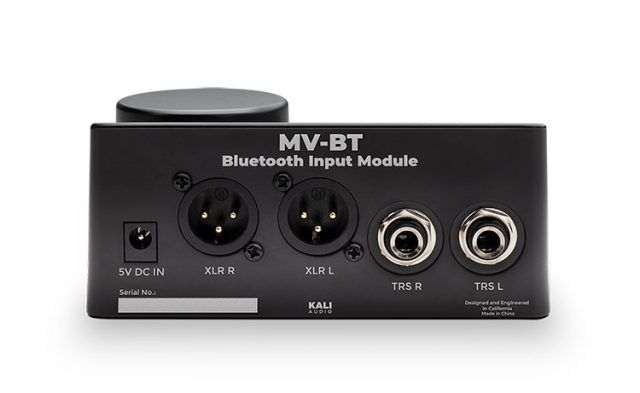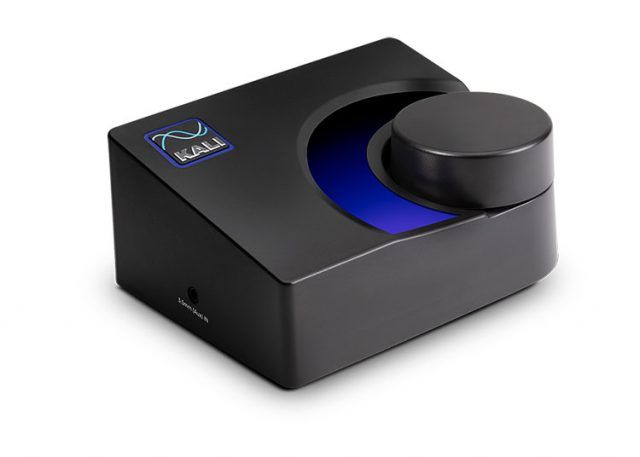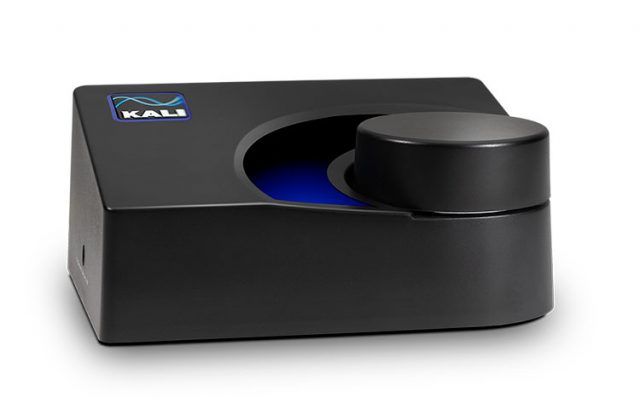As more mobile devices shed their dedicated audio outputs, Bluetooth audio has become essential to consumer audio but is also showing up in a growing number of pro audio loudspeakers, as well as DJ mixers and controllers. But if you’d like to add Bluetooth audio compatibility to your existing setup, Kali Audio has a low-cost dedicated module for you: the MV-BT. This review examines the unit’s audio quality, performance, and value.
- Reviewed: MV-BT: Mountain View Bluetooth input module and monitor controller
- Manufacturer: Kali Audio
- Price: $99 MSRP
- Inputs: Bluetooth, 3.5mm aux
- Outputs: Balanced stereo XLR, balanced stereo TRS
- Power Source: 5V DC (wall wart included)
- Dimensions: 3.15” (80 mm) H x 5.28” (134 mm) L x 5.12” (130 mm) W
- Weight: 1.1 lbs (0.5 kg)
Li’l Bluebox
As wireless Bluetooth audio was taking over smartphone listening, it was also showing up in a growing array of DJ gear. You’ll now find it primarily in different types of loudspeakers and PAs, but also in some DJ mixers from the likes of Reloop or Denon and in all-in-one controllers such as the Hercules Universal DJ and the Pioneer DJ DDJ-200. But most of the Bluetooth-capable loudspeakers cost hundreds of dollars per speaker. What if you would like to have some Bluetooth connectivity in your setup without replacing your existing gear?

For just that purpose, Kali Audio—makers of the impressive LP-series monitors and the new IN-series monitors—has produced the MV-BT ($99 MSRP), a small and simple-to-use Bluetooth monitor controller for sending Bluetooth audio to any speakers, mixers, or audio interfaces through its balanced XLR and 1/4-inch TRS outputs. The balanced audio connections let you use long runs of cable without introducing extra noise into the signal.
The MV-BT takes up only about a 5-by-5-inch footprint on a desktop, and the included AC wall adapter powers it. There’s no power switch, so it powers up when you plug it in, and it immediately begins seeking Bluetooth devices for pairing. You can also long-press the Kali logo button for 2 seconds to disconnect a connected device and enter pairing mode again. This button’s blue LED ring flashes when it’s pairing and goes solid when it’s paired.
Once the MV-BT pairs to a Bluetooth audio device, both the XLR and TRS audio outputs become active, and you can simultaneously use speakers on both sets of outputs. The MV-BT will output audio from only one Bluetooth source at a time. There is also a 3.5mm aux input jack for playing audio from a wired connection. Plugging into the aux input jack disables the Bluetooth audio output.

A large weighted volume knob controls the audio output level and has a blue LED backlit volume meter. This knob moves in notched segments, and there are 50 notches between zero audio and full-level audio, so you have a fine level of volume control.
Audio Quality
Every time I paired a Bluetooth audio device to the MV-BT there was a noticeable hiss introduced to the output, whether the audio from the device was active or not. When disconnecting Bluetooth, the hiss disappeared. But the hiss comes back when plugging in the 3.5mm aux input, so it must not be tied to the Bluetooth connection but rather the hardware. The hiss appeared regardless of which speakers I connected or whether I paired a laptop, Android phone, or iPad to the Bluetooth audio.
However, the hiss was less audible when using a pair of Kali Audio LP-6 monitors than it was when using a different pairs of KRK Rokit monitors. That may have to do with how each set of monitors deals with those frequencies. Fortunately, the hiss noise did not increase with increased volume, so the more I turned up the volume, the less noticeable it was.
The best scenario is to set the volume of the connected audio device to full level, and use the MV-BT’s independent volume control from there.
The MV-BT uses the aptX Codec, which Kali Audio writes, “allows compatible devices to stream CD-quality audio over Bluetooth with minimal latency.” I compared streaming audio played over the MV-BT’s Bluetooth connection with the same streaming audio source played through the highly-respected Universal Audio Arrow USB-C interface, and there was no discernible difference in audio quality, so I could not ask for a better result than that.
Also, there was no discernible difference in the audio quality coming from the XLR and TRS outputs.

The Operative Word is Minimal
While the MV-BT’s Bluetooth codec promises minimal latency, there is still some latency, which is important for DJs to know if they’re considering using the MV-BT to output Bluetooth audio from their DJ software or apps.
The latency I experienced differed on various hardware. For example, on a 2011 MacBook Pro running Traktor 3, the latency between doing an action—such as hitting Play or a cue point, turning on an effect, etc.—and hearing the audio was a lot worse than it was on a recent iPad Pro running Algoriddim djay. Either way, the slight latency was noticeable, and as a result, it was at best distracting and at worst disruptive for performing a DJ set.

Conclusion
Kali Audio never really presents the MV-BT as a zero-latency Bluetooth module suited for live performance, so keep in mind that the MV-BT’s value is for incorporating a Bluetooth audio option into your setup without having to purchase a whole new set of monitors or expensive loudspeakers.
When you use the MV-BT as a supplementary source going into your multi-input monitors or a mixer, it’s a convenient way to make any audio system Bluetooth-compatible, but it’s not necessarily meant to be your main audio interface for DJ performance.





